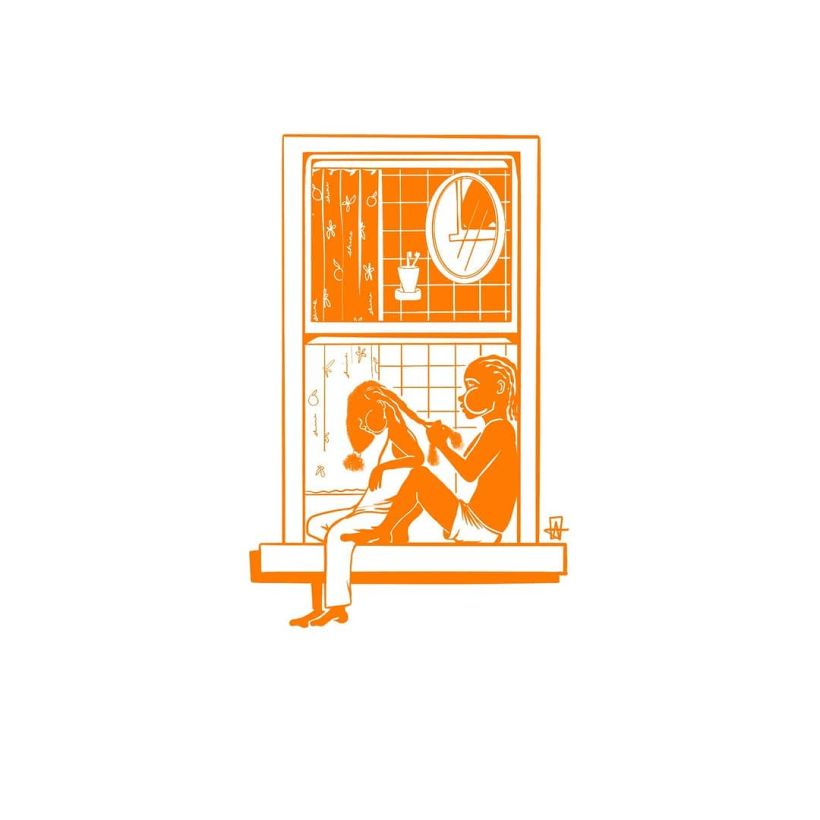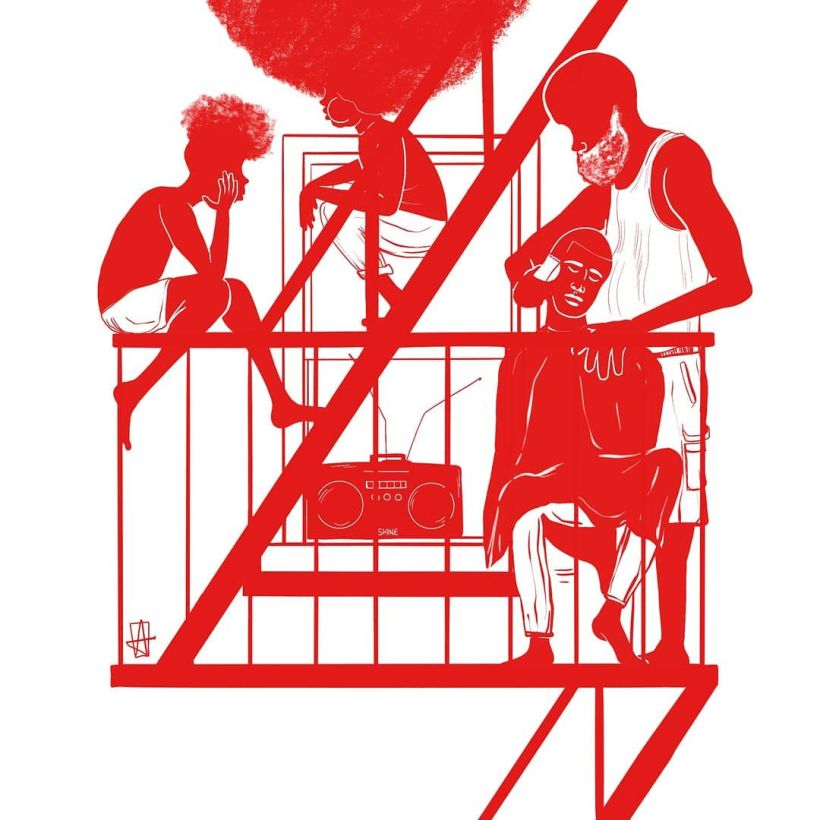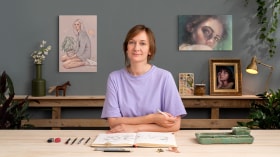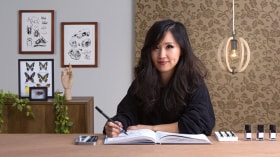Adrian Brandon on Creating Art That Starts a Conversation
The Brooklyn-based artist talks about the power of art to start a conversation about Black lives and Black culture
Adrian Brandon (@ayy.bee) is an artist dedicated to raising awareness of injustice towards Black people, and celebrating and creating an understanding of Black culture, “and the unique joy, swagger, and love that is shared in our community”.
For Adrian, creativity has always been a huge part of his identity, “I was that kid in the back of the classroom doodling way too much and not paying attention in class.” Having grown up in a crafty household–in which Mother’s Day called for designing a full brunch menu and pulling flowers from the garden, while his father’s birthday was preceded by making a chessboard and all its pieces out of clay–he credits his parents for fuelling his early interest in art.

“I feel very fortunate that both my parents understood the importance of creativity and pushed it on us at an early age, not necessarily to become an artist or anything like that, but just understanding that it can be a love language, it can really change an environment, it can create a home away from home, or tell a story,” says Brandon.
Since 2019, he has been working on “Stolen,” a series of powerful portraits of Black individuals whose lives were robbed from them at the hands of the police. Each portrait is incomplete because, aside from markers and pencils, Adrian uses time as a medium. How old the subject was when their life ended determines how much time Adrian spends coloring in each portrait. Every time Adrian sits down to work on a piece, he sets a timer: one minute of color for one year of life. George Floyd was 46 years old when he was murdered, so Adrian colored his portrait for 46 minutes. Breonna Taylor was 26 when she was murdered, so Adrian colored her portrait for 26 minutes. Tamir Rice was 12 when he was murdered, so Adrian colored his portrait for 12 minutes. “I'm not looking at the timer, it's off to the side. Sometimes, I think it is broken because it feels like I've been coloring for longer than I anticipated in my head. Other times, it goes off in half the amount of time,” he says.



“I wasn't anticipating feeling so anxious or stressed as I created the pieces, I just thought that the viewer would be left with this unfinished portrait and that alone would be powerful enough. I didn't think that it would have this, sort of, performance within, just of myself feeling, ‘OK, this timer is going down, how does that affect my process while I create? How do those feelings of anxiety and feeling rushed and fearful represent or relate to the idea of Black people feeling fear and anxiety living in America and engaging with the police?’ Even though I've done over 50 portraits for this series, those feelings don’t go away.”
After attending high school in Seattle, Adrian moved to Los Angeles to attend Pitzer College, where he studied art and architecture. It was there that Adrian began to feel more confident about speaking out and sharing his own experiences as a Black man living in the United States. He discovered that his art was a way to engage people and get them thinking about important issues.
“I didn't learn many technical skills [at college], but I did learn how art, for me, is a great tool to talk about my feelings towards a lot of social injustices that the Black community faces. In school, I was often in a lot of white spaces–I was one of five Black boys in my class in college. I struggled internally with that, and art became a great outlet for me to connect with others and share my perspective. I can’t speak for all Black people, of course not. I have my own experience, and, in college, I learned to share that more and be more vulnerable with that through my art.”


Adrian remembers seeing the effect that his work could have on others after painting some murals.
“Seeing how something I created could spark conversation or spark an article or two or have people just stop on their way to class and look at it and think, I loved that, and I think that's the beauty of art, you're able to share stories that other people aren't able to connect with on their own. It felt incredibly therapeutic. I was personally very affected by a lot of the things I was seeing in the world: the death of Trayvon Martin... the Black Lives Matter movement... I was emotionally pulled in that direction, and wanting to figure how I could get through that and connect with others: art was an obvious language for me.”
One of those murals was an image of protestors from the civil rights era gradually transitioning into a scene of protesters from Ferguson; Adrian left the signs that the protesters were holding blank and, over time, students on campus began filling them in with words and sentiments that they were passionate about, relating to the BLM movement. “I painted [another] mural of two large faces with the US flag flowing behind them. A part of the flag covered the eyes of the White man and covered the mouth of the Black man. These murals were my first public works, and I learned how vulnerable having public work was. I believe being vulnerable is incredibly powerful. I have painted a total of four murals, two in LA, one in Costa Rica, and one in Taiwan.”

In November 2019, Brandon exhibited "Stolen" as part of his first-ever solo show. For the artist, it has been remarkable to see his work being used to start conversations about race and remind people that we can never allow ourselves to become numb to injustice. “I think right now the focus is just continuing to see where this series can go and how far it can grow in terms of its reach and continue to inspire people to keep talking about it and to consider their role in the movement and how they can help us to get to a point where people feel safe.”
In 2018, after being inspired by the work of Karen Goins (@_karen.goins_), Adrian began collecting colored markers and learning to combine and blend them to create portraits.
“Markers are definitely my favorite [tool]. The fact that I can layer them and blend them... I'm not a painter, but I feel like I'm still painting with these; it's not how most people would use a marker. Now I'm exploring using color pencils and pastels in combination with the markers–that's my latest endeavor. It's funny because I used to hate using color. I used to only work in the simplest color or monochrome or as much black as possible. Now I use probably 30 colors in one portrait for the Stolen series. But other pieces can get up to 70 or 80 colors, so I've definitely flipped on my use of color.”
When asked about his preferences when it comes to materials, Adrian replies, “My favorite brand and model of markers are Copic Sketch markers. I love Strathmore Bristol paper, but I use Strathmore's marker paper for the Stolen Series.”
It was through sheer dedication that he learned and honed his technical skills. He recalls setting himself a challenge early on to draw one Black cultural icon a day for 30 days in honor of Black History Month. “Stolen is a lot heavier, it's more difficult to digest. My other work, I try to make it a little bit more celebratory of Black culture. We're tired of always seeing our stories through pain and suffering and all the shit we have to go through, so I definitely need to create art that's the opposite of that and show that, ‘Hey, despite all that, we're still magic and flowing and beautiful.’ It's such a different emotion.” His other work, a mix of digital and hand-drawn pieces, touch on everything from the power of basketball to make a Black child feel like they belong, to how windows can bring together a community, or the joy a child experiences as they race through the streets on their bike while their durag dances in the wind.



“I definitely build out the concept and have everything pretty clear to me before I begin. Almost to a fault sometimes; I will not start creating unless I have everything built-out in my head. While I think that's helpful in some regards, sometimes I should just get messy and play with it and see what comes of it. But I also really gravitate towards art where I understand what the artist is saying, a message is clear. There's some art to me that feels very inaccessible, and I don't understand how I'm supposed to digest it. For me, I just love when people can see my intent, just as long as they get the general idea of what I'm exploring, that's important to me.”
Discover more of Adrian’s work and visit his online store here.
You may also like:
–Creatives For Black Lives Matter
–Add Emotion and Poetry to Portraits in Procreate
–How to Create a Portrait in Photoshop in 8 Easy Steps







0 comments